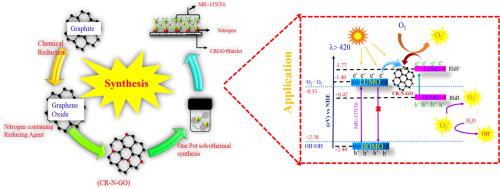当前位置:
X-MOL 学术
›
Appl. Surf. Sci.
›
论文详情
Our official English website, www.x-mol.net, welcomes your
feedback! (Note: you will need to create a separate account there.)
Inhibiting photocatalytic electron-hole recombination by coupling MIL-125(Ti) with chemically reduced, nitrogen-containing graphene oxide
Applied Surface Science ( IF 6.3 ) Pub Date : 2021-03-01 , DOI: 10.1016/j.apsusc.2020.148503 Rida Fatima , Jong-Oh Kim
Applied Surface Science ( IF 6.3 ) Pub Date : 2021-03-01 , DOI: 10.1016/j.apsusc.2020.148503 Rida Fatima , Jong-Oh Kim

|
Abstract In this study, we fabricated a novel chemically reduced nitrogen containing graphene oxide (CR-N-GO) modified metal organic framework, (MIL-125(Ti)) by one-pot solvo-thermal approach for its application in photocatalytic degradation of xenobiotic organic pollutants. CR-N-GO has nitrogen present as impurity on its surface therefore, aim of this study was to signify the importance of that nitrogen for enhancement of visible light activity of photocatalyst. The r-N-MIL (modified MIL-125(Ti)) photocatalyst was characterized to obtain structural, optical, and surface properties. This characterization suggests mesoporous structures with improved surface roughness and visible light capturing property. Photocatalytic degradation of Rhodamine B (RhB) increased 2.0-fold under visible light compared to that of the pristine MIL-125(Ti). Enhanced photocatalytic activity under visible light was attributed to p states induced by oxygen bonding of MIL-125(Ti) oxo clusters with CR-N-GO, nitrogen incorporation into MIL-125(Ti) from CR-N-GO, localized electronic states of Ti-O-C bonds and mesoporous structure. Moreover, photoexcitation, radical generation, and photocatalytic degradation steps exhibited the photocatalytic degradation mechanism. Furthermore, LC/MS analysis identified chromophore cleavage, ring opening, and mineralization as major photocatalytic degradation pathways. Performance evaluation through catalyst surface efficiency and apparent quantum yield is on par with those of other catalysts and describes r-N-MIL as a fascinating semiconductor photocatalyst.
中文翻译:

通过将 MIL-125(Ti) 与化学还原的含氮氧化石墨烯偶联来抑制光催化电子-空穴复合
摘要 在本研究中,我们通过一锅溶剂热法制备了一种新型化学还原含氮氧化石墨烯 (CR-N-GO) 改性金属有机骨架 (MIL-125(Ti)),用于光催化降解异生有机污染物。CR-N-GO 表面存在氮作为杂质,因此本研究的目的是表明氮对增强光催化剂可见光活性的重要性。rN-MIL(改性 MIL-125(Ti))光催化剂被表征以获得结构、光学和表面特性。这种表征表明具有改善的表面粗糙度和可见光捕获特性的介孔结构。与原始 MIL-125(Ti) 相比,罗丹明 B (RhB) 在可见光下的光催化降解增加了 2.0 倍。可见光下增强的光催化活性归因于 MIL-125(Ti) 氧簇与 CR-N-GO 的氧键合诱导的 p 态,氮从 CR-N-GO 掺入 MIL-125(Ti),局部电子态Ti-OC 键和介孔结构。此外,光激发、自由基产生和光催化降解步骤表现出光催化降解机制。此外,LC/MS 分析确定发色团裂解、开环和矿化是主要的光催化降解途径。通过催化剂表面效率和表观量子产率进行的性能评估与其他催化剂的性能评估相当,并将 rN-MIL 描述为一种迷人的半导体光催化剂。
更新日期:2021-03-01
中文翻译:

通过将 MIL-125(Ti) 与化学还原的含氮氧化石墨烯偶联来抑制光催化电子-空穴复合
摘要 在本研究中,我们通过一锅溶剂热法制备了一种新型化学还原含氮氧化石墨烯 (CR-N-GO) 改性金属有机骨架 (MIL-125(Ti)),用于光催化降解异生有机污染物。CR-N-GO 表面存在氮作为杂质,因此本研究的目的是表明氮对增强光催化剂可见光活性的重要性。rN-MIL(改性 MIL-125(Ti))光催化剂被表征以获得结构、光学和表面特性。这种表征表明具有改善的表面粗糙度和可见光捕获特性的介孔结构。与原始 MIL-125(Ti) 相比,罗丹明 B (RhB) 在可见光下的光催化降解增加了 2.0 倍。可见光下增强的光催化活性归因于 MIL-125(Ti) 氧簇与 CR-N-GO 的氧键合诱导的 p 态,氮从 CR-N-GO 掺入 MIL-125(Ti),局部电子态Ti-OC 键和介孔结构。此外,光激发、自由基产生和光催化降解步骤表现出光催化降解机制。此外,LC/MS 分析确定发色团裂解、开环和矿化是主要的光催化降解途径。通过催化剂表面效率和表观量子产率进行的性能评估与其他催化剂的性能评估相当,并将 rN-MIL 描述为一种迷人的半导体光催化剂。











































 京公网安备 11010802027423号
京公网安备 11010802027423号